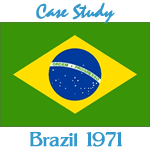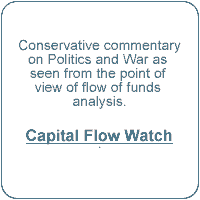 Lessons: Brazilian Stock Market Bubble of 1971
Lessons: Brazilian Stock Market Bubble of 1971
Case Study: The Brazilian Stock Market
A Non-cyclical, Irrational Stock Market Bubble
Lessons of the Brazilian Bubble
The main lesson of the Brazilian Bubble of 1971 is simply that it pays to try to understand capital flows.
Markets are not cyclical: Although the graph of the Brazilian market over the period 1968 to 2004 shows three distinct bubbles in equity prices, it would be a mistake to conclude that stock markets are cyclical. Each of the three booms were caused by distinctly different capital flows. The market was evolving, not repeating.
Conditions that led to the Wall Street Crash of 1929 were never repeated, but there were other crashes for other reasons.
In fact, as far as I know, no two stock market bubbles, in any part of the world, at any time, have been identical or have been repeated. The U.S. Crash of 1929 and the Crash of 1987 were distinctly different, as was the Crash of 2000. The destruction of the Indonesian market in 1997 was different again.
If markets are evolving, not repeating, this means that there is something fundamentally wrong with fitting trends to stock prices by using statistical methods based on a presumption of comparable data in an attempt to develop 'rules' of market behavior.
Market cycles are an illusion. Capital flows that drive prices up and down are reality.
Markets are often irrational: The two key forces the drove the market up and then down — the automatic investment in 157-funds and the blocking and then release of new issues by the market regulator — were certainly not the actions of a 'rational investor' about which economists fantasize.
In fact, the whole market in 1971 seemed to be irrational: the brainless channeling of tax money into 157 funds; the thoughtless withholding of new issues from market for no good reason; and the fitful antics of the speculators, margin traders, and manipulators.
Prices don't adjust immediately to pre-boom values: Once the log jam of new issues was broken, prices did not immediately fall to pre-boom levels. Instead, values eroded away, bit by bit, for over a decade. As individuals got out of the market, the interplay of forces between 157-funds and issuers continued. As long as prices were high compared to pre-1971 levels, issuers continued to soak up tax money flowing into 157-funds.
Booms and busts restructure institutions: The long, drawn-out slide in stock prices following the Bubble of 1971, had permanent institutional effects on the Brazilian market.
- First, Rio brokers whose business depended mainly on individual investors, suffered a fatal blow, especially after the public announcement by leading brokers in the last quarter of 1971 that 'the market was fundamentally sound' and the market continued downwards for a decade.
- Second, the licensed investment banks (owned by commercial banks) could now dominate the largest 157-funds and control the underwriting market. Since most of these banks were headquartered in São Paulo, where they had broker-dealers as subsidiaries, the decline of the Rio Exchange was hastened.
- Third, the Rio brokers, having failed to take action on the modernization plan requested by Minister Bulhões, and generally lacking the institutional structure of the new brokers that were backed by commercial banks, continued to operate precariously.
- When another speculative boom came along in the mid 1980s, Rio brokers were already fatally flawed by lack of internal controls and administrative discipline. In 1989, a speculator passed a bad check for $10 million, throwing the clearing system into such disarray that the Rio Exchange never recovered.
No one knows the intrinsic value of equities : The Efficient Market Hypothesis is predicated on the notion that there are enough 'smart people' in every market to be able to figure out the intrinsic value of equities and make sure that prices do not stray too far from this magic number.
Of course, 'intrinsic value' depends on the discounted present value of the future stream of dividends over the next one hundred years. Who, in Brazil in 1971, could possibly have had any rational basis to predict what was going to happen in even ten years?
It might have been possible to predict that stock prices would fall in 1971 when the Central Bank began to approve new issues, but no one could foresee the end of the Brazilian Miracle in less than a decade.
Furthermore, even those who might have pessimistic expectations of the future, no one (that I ever met), actually foresaw the 'lost decade' of the 1980s, or the string of years with inflation of over 1000% during the 1990s.
Therefore, this lesson ends with this thought: Capital Flow Analysis should be at least as important as fundamental or technical analysis to the serious professional.
Although markets are not always as easy to read as the Brazilian market of 1971 (in retrospect), potential profits (or avoidance of loss) from successful Capital Flow Analysis is worth the effort.

